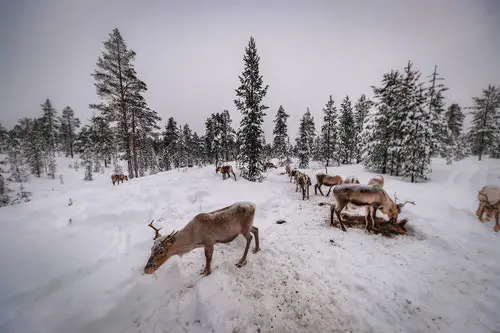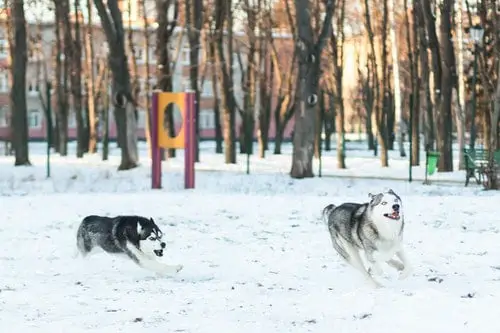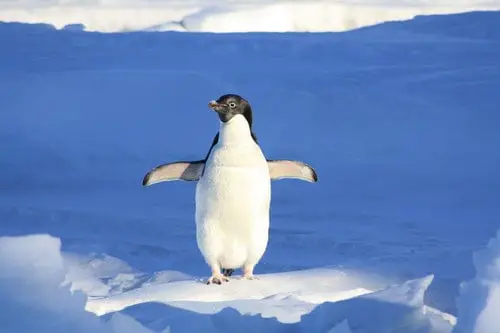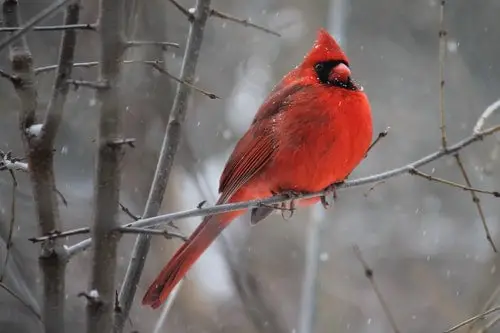Animals have specific adaptations that enable them to stay warm in winter. These adaptations vary from one animal to another, though some of these animals do have similar adaptations that help them stay warm in winter.

Mammals.
The hair of mammals serves as a source of insulation in cold weather. In cold weather, these hairs stand erect, trapping air, a very good insulator, next to the skin. This blanket of air prevents heat from escaping into the atmosphere. The greater the hairs, the greater the amount of trapped air, and hence, the greater the insulation.

Blubber, a special layer of fatty tissue helps keep aquatic animals warm in winter. Not all aquatic mammals develop blubber. Sea otters, for example, do not develop blubber. However, blubber is a defining feature of most marine mammals.
It accounts for as much as forty percent of the mass of most marine animals. It’s the thickness and density aids immensely in keeping marine animals warm.
Also, blubber has a relatively low thermal conductivity. It does not conduct heat as well as muscles.
In the summer, most mammals eat more. They do this, so they can store fat for the upcoming winter. When winter does come, some of them hibernate, and their body fat serves as a welcome source of warmth.
Other animals like the North American black bear, lower their body metabolism, without a drop in body temperature.
Reptiles And Amphibians.
Apart from very few reptiles, Reptiles are poikilothermic (cold-blooded) animals. Unlike warm-blooded animals like mammals and birds, reptiles can not maintain their internal body temperature.
Their internal body temperature changes with changes in temperature of the environment. Hence, reptiles have to rely on other means to stay warm in winter.
Some reptiles become inactive during winter. Their heart rate decreases drastically, and their body metabolism becomes very slow. They do not hibernate, but they limit their movement and activities to conserve energy. This process is known as brumation.
During this process, these reptiles conserve vital energy, that will provide warmth during the long winter days.
Reptiles find shelters to help shield against the intense cold. Some create their shelters. These shelters range from abandoned burrows to crevices.
However, ideal shelters for winter are usually underground. Some reptiles burrow into compressed snow. This type of shelter is quite ideal. It functions just like an igloo would, and it certainly helps them stay warm. These shelters also serve another function for these reptiles.
Most of them hibernate throughout the winter in these shelters, hence frugally managing their only heat source; their body metabolism.
Not all reptiles can burrow deep into compressed snow to get an ideal shelter. Hence, they have to bear the full force of the winter cold. The wood frog is an example of such a reptile. Their bodies freeze during winter, and their hearts stop beating.
They appear completely frozen. However, because of the high concentration of glucose in their blood cells, they do not die. The glucose serves as an anti-freeze, and also as a source of nourishment. Hence, when the temperature increases, these reptiles slowly thaw out of their seeming death and spring to life.
Some aquatic frogs like the bullfrog hibernate at the bottom of shallow bodies of water with the muddy substratum. Different reptiles and amphibians stay warm in winter in different ways, but hibernation, and burrowing for shelters are the most common ways.

Fishes.
Fishes are also cold-blooded animals. They are also aquatic animals. When winter arrives, ponds, lakes, and rivers freeze. However, the fishes in these water bodies do not freeze to death. This is because of only the top of these water bodies freeze. The bottom doesn’t.
This is because of a unique property of water; it’s anomalous expansion. The density of water increases as temperature decreases, but when the temperature drops to four degrees, the density decreases from four degrees to zero degrees, causing any ice that forms to float, because the ice is less dense than the liquid water.
This phenomenon helps keep the fishes alive and prevents them from freezing in winter. However, not all fishes can withstand very cold temperatures. Hence, they have to rely on other adaptations.
When winter approaches, some fishes make seasonal movements in search of warmer water bodies. Fishes that migrate to warmer water bodies are usually those that can’t withstand freezing temperatures. Generally, shallow water bodies are much warmer than deep water bodies.
In marine water bodies, the high concentration of salt decreases the freezing point of water, just like an anti-freeze. Also, some species of fish have antifreeze proteins in their blood that prevent it from freezing.

Birds.
The main source of insulation against cold in birds is feathers. Many birds grow extra feathers in preparation for winter. Like the mammalian hair, these feathers trap pockets of air around the body of the birds. This air serves as an insulator and greatly reduces heat loss to the environment.
Feathers insulate better when clean, dry, and flexible. Different species of birds have different ways of keeping their feathers dry and waterproof. Whatever method is used, dry waterproof feathers help keep birds warm.
The legs of birds are covered with specialized scales that help minimize heat loss. Also, some birds prevent the blood in their feet from circulating throughout their bodies.
Since the blood in their legs is colder than the blood flowing in their bodies, letting the blood in their legs circulate throughout their bodies would reduce their internal body temperature. Restrictions the circulation of the blood in their feet through putting ting their bodies helps raise their body temperature.
The Alpine Swifts, which are prominent in Southern Europe, have a special adaptation that helps them stay warm in winter. When the ground becomes too cold, they take to the skies and can remain there for about six months. They do not have to stop for food, they can feed on plankton that resides in the air.
